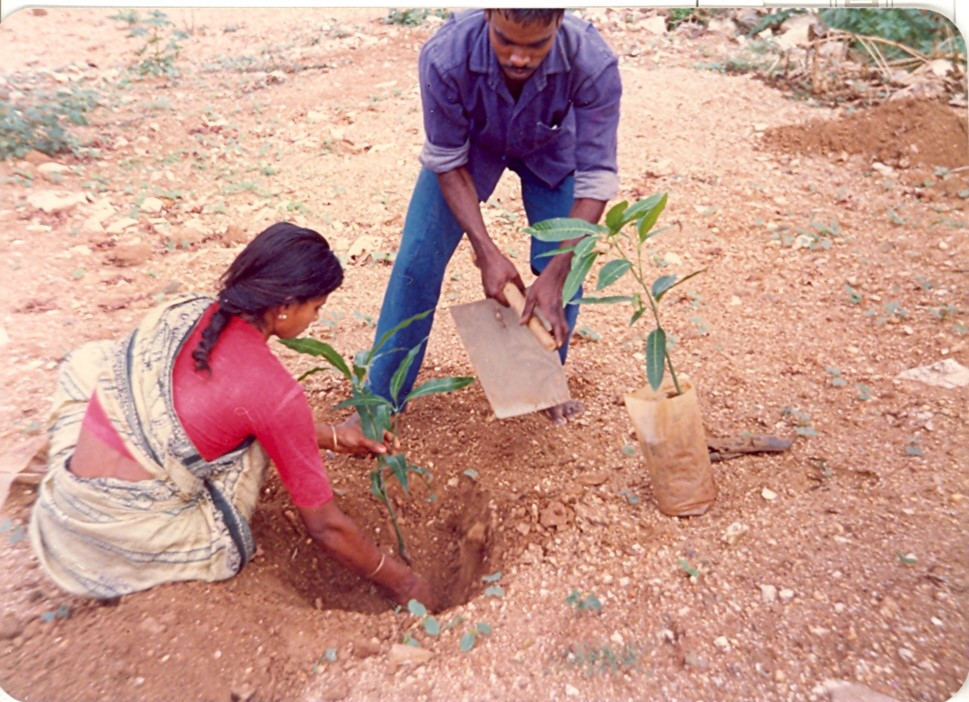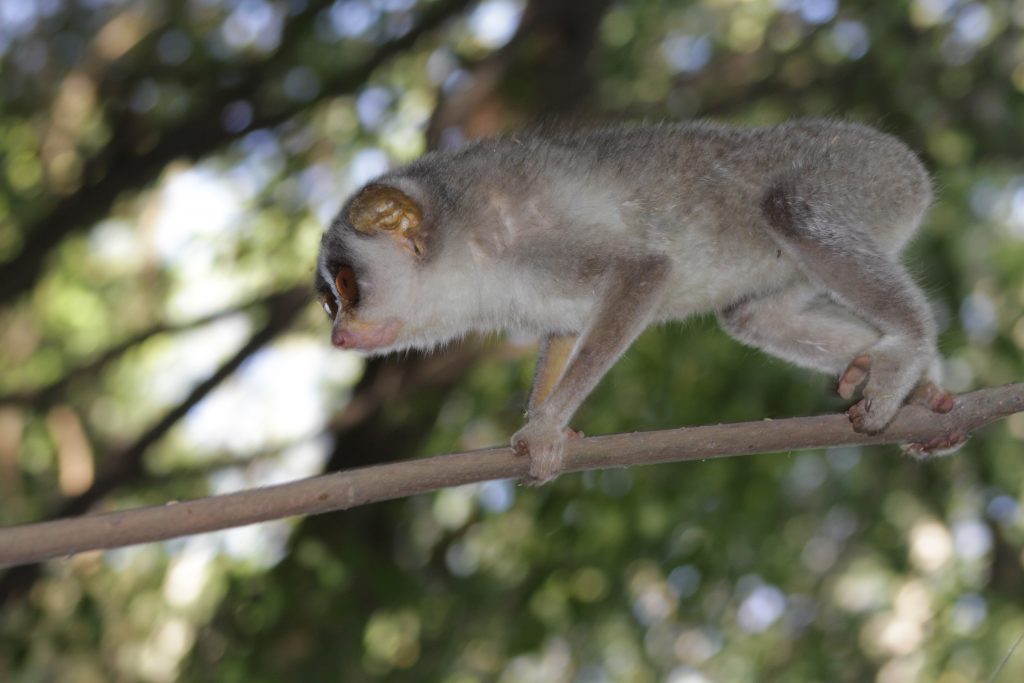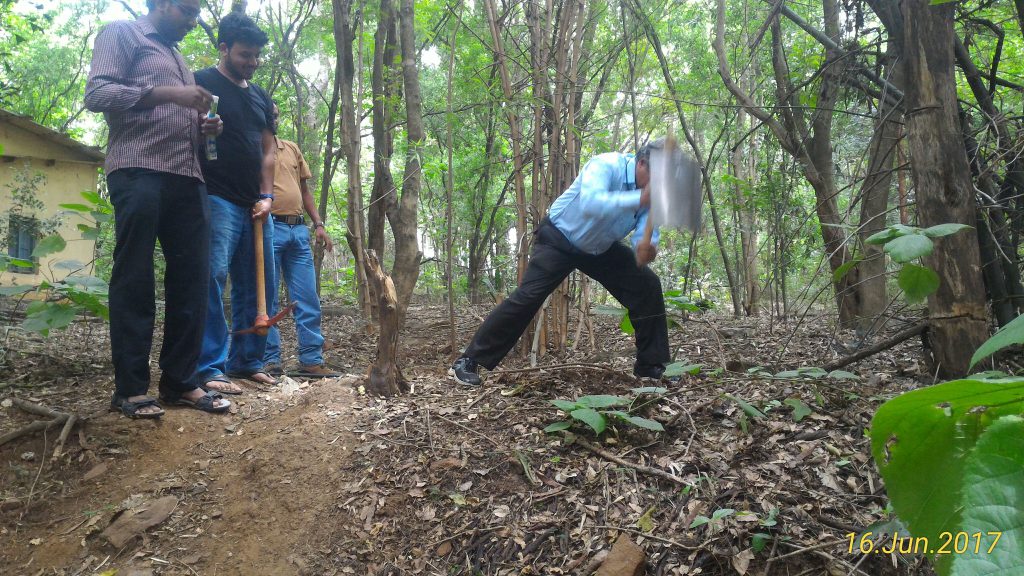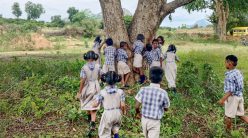A small woodland in IISc is the result of a successful three-decade-long ecological experiment

(Photo: Subash Chandra NS)
In the heart of Bangalore, a city known for its beautiful gardens and majestic trees – now dwindling – lies the lush green campus of IISc. Within it is a small patch of unmanicured woods, populated by over 49 tree species, many of them from the Western Ghats, besides several animals, including a variety of birds, butterflies, reptiles and primates.
The origin of this woodland, popularly known as the mini-forest, dates back to 1985 when CNR Rao assumed office as the Director of the Institute and Madhav Gadgil was the Convenor of the Centre for Ecological Sciences (CES), established in 1983.
Before the beginning
For a few years then, Madhav, who was initially part of the Centre for Theoretical Studies at IISc, and his colleagues had been studying the ecology of the Western Ghats. He ran a field station in Dandeli, which was shifted to Sirsi, also in the Uttara Kannada district of Karnataka, in 1980.
The nursery in the field station had become the centre of a thriving ecodevelopment project. Madhav and others were helping villagers replant the hills with native trees, trying to save the local vegetation that was soon disappearing because of arecanut monocultures.

DM Bhat, then a Scientific Assistant at CES who was working at the field station grew indigenous plant saplings for the revegetation programme with the help of his staff. The saplings from the field station, including bamboo from Dandeli, and plants from the forest department, would eventually make their way into the mini-forest.
From a scrubland to a forest
In 1985, the Institute proposed the construction of two buildings located close to each other: one for CES and another for the Centre for Electronic Design and Technology (now the Department of Electronic Systems Engineering). But Rao insisted that the buildings be spaced apart to make room for some greenery on the campus.
“So, we proposed the idea of planting tree species of the Western Ghats,” says TV Ramachandra, a Scientific Officer at CES, who heads the Energy and Wetlands Research Group. The Institute allocated a 1.75-hectare plot right opposite the place where the CES building was to come up. Ramachandra, along with CJ Saldanha, a Professor at CES, and Madhav implemented the project. Two workers, Venkatiah and Venkatalakshmi, helpers at CES, watered the plants and removed the weeds in the initial stages. Raghavendra Rao and Manjunath, field assistants at CES, Venkatappa, Mechanic, and Murugeshachar, helper, fenced off the area and monitored it.

During the implementation of the project, there was one mishap. “Regretfully, it [the mini-forest] has some admixture of exotics because one of the daily wage workers in the nursery, without checking with us, brought some exotics from the forest department’s nursery, where the husband of a friend of hers was employed,” Madhav recollects.
In addition to its primary goal of preserving the green cover on the campus, the mini-forest was planted to understand important questions about ecological dynamics: how adaptable are rainforest trees in a novel habitat and what is the nature of the relationships they develop in the new environment? The performance of these trees was monitored for 23 years and was reported in a research paper authored by Sankara Rao (a retired professor from the Biochemistry Department now in charge of the CES herbarium), along with CES researchers Harish Bhat, Varsha Kulkarni and Ramachandra.
The mini-forest, according to its authors, has been a successful experiment, one which showed that many plant species from wet evergreen forests can survive and thrive in a foreign habitat. As Rao and his colleagues put it in their paper, the trees grew “as good as they would in their native habitat” despite the difference in the annual rainfall.
Over the years, the mini-forest has also become a refuge for animals rescued from other places, where their lives would have been under threat
The gigantic climber, Entada rheedei Spreng, planted opposite the mini-forest, in front of the old CES building at the Silver Oak Marg, stands as a great testimony to this. The liana, which is extremely difficult to grow in a habitat other than its natural one, has flourished, climbing into the mini-forest across the road.
The mini-forest has had other ecological benefits. In the same paper, the authors reported that the mini-forest area was cooler than other parts of the campus by as much as 2°C. It has also helped recharge the groundwater. “The water table at this location was in the range of 60 – 70 m depth before creating the mini-forest. Present monitoring of the water table shows the level of water is at about 3 to 3.5 m below the ground,” they write.
Conserving urban ecology
In a bustling city like Bangalore, which has lost over 95% of its tree cover to construction projects in the last five decades, the mini-forest is one of the few spaces conserving biodiversity. Such a model of conserving biodiversity in patches that preserve the natural biota spread across the country is far better than just having pockets of wilderness like wildlife sanctuaries and national parks in a few places, explains Madhav. “This is consistent with ecological theories and is rooted in our traditional methods of conservation,” he says.
Anindya Sinha, Professor at the National Institute of Advanced Studies (NIAS), who studies behavioural ecology and has always been deeply interested in the flora and fauna of the campus, speaks about the dichotomy of thought associated with urbanisation – of maintaining natural existence before urbanisation vis-à-vis creating aesthetic, green, exotic spaces. “Manicured spaces are impositions on nature,” he says. “Such cultivated spaces lose the flora and fauna of the region. But we urbanites have an exclusionary outlook: us as space-makers who assign spaces for species, rather than enabling them to establish their own.”

(Photo courtesy: TV Ramachandra)
In contrast to this exclusionary view, the mini-forest has become a home for animals that are soon disappearing from the city due to habitat loss. Take for instance the slender loris: a small, nocturnal primate that inhabits this forest. An adult slender loris is about 25 cm long, weighs about 275 g and has large brown eyes with reflective membranes. These animals, who once inhabited the shrubs and bamboos of Bangalore, are now rarely seen.
The mini-forest is now one of the few green covers in the city with a healthy loris population. “I am proud of the mini-forest in that we could demonstrate the conservation of slender loris,” Madhav says.
In a bustling city like Bangalore, which has lost over 95% of its tree cover to construction projects in the last five decades, the mini-forest is one of the few spaces conserving biodiversity
These lorises have also proved helpful in understanding urban ecology, adaptation of wildlife to human habitation, and animal behaviour by researchers like Kaberi Kar Gupta. In 2014, Kaberi, then a Visiting Scientist at CES, founded a citizen science initiative called the Urban Slender Loris Project to study the dwindling loris population in urban spaces, a project that continues to this day.
Sindhu Radhakrishna, Professor at NIAS, has also spent a lot of her time studying lorises in the mini-forest. Her research has ranged from understanding vocal communication in the lorises to how these shy, nocturnal primates adapt their food habits in new habitats.
In the early 2000s, when she first started studying the lorises on the campus, Sindhu asked people of this part of the city about the last time they spotted a loris. While some described their parents’ memories of growing up with lorises, the current generation did not remember them – some had not even heard of them. “I think it correlates with our consistent loss of green patches,” Sindhu says. “Only large educational campuses like IISc can still afford to keep these patches of greenery that are crucial for the species that have quietly co-existed alongside us for years. They can continue to exist only because of these small patches.”
The butterflies of the mini-forest have also been of interest to ecologists. Nitin Ravikantachari, a PhD candidate at the University of South Carolina in the US, monitored butterflies in Bangalore from 2012 to 2017. This study of seasonal fluctuations in species abundance and diversity brought him to the mini-forest.
“I used to visit the IISc campus and the mini-forest for about three hours every alternate Sunday to monitor butterfly species diversity and abundance,” Ravikantachari says. He recalls how Suman Attiwilli, then a PhD student at IISc, showed him the place around the mini-forest. Monitoring these butterflies has helped him learn a lot about their life histories. “This has definitely influenced a lot of the research that I conduct now,” he says.

(Photo courtesy: TV Ramachandra)
Some of these findings have culminated in a book, Butterflies of Bengaluru, which he co-authored with Krushnamegh Kunte, Associate Professor at the National Centre for Biological Sciences (NCBS).
Over the years, the mini-forest has also become a refuge for animals rescued from other places, where their lives would have been under threat. In 2011, Rahmath Ataz, a wildlife enthusiast, helped rescue an ailing slender loris found in the Chamundinagar area of Bangalore. The loris was released into the mini-forest. Ramachandra also mentions that snakes captured at different parts of the campus have been released into the mini-forest.
Inspiring the next generation of ecologists
The mini-forest has thus become a source of inspiration for the next generation of ecologists like Nitin. Ramachandra and his colleagues are making efforts to inspire many more. “We have the environment education programme where the school children visit the campus, monitor the biomass of the trees and identify the species,” Ramachandra says. In one such programme held on 30 November 2017, a group of school kids planted about 500 saplings of five different varieties of ficus trees in Jubilee Gardens at IISc. He hopes that many more will take it upon themselves to plant more trees.
Joel P Joseph is a PhD student at the Centre for BioSystems Science and Engineering (BSSE), and a former science writing intern at the Office of Communications, IISc




